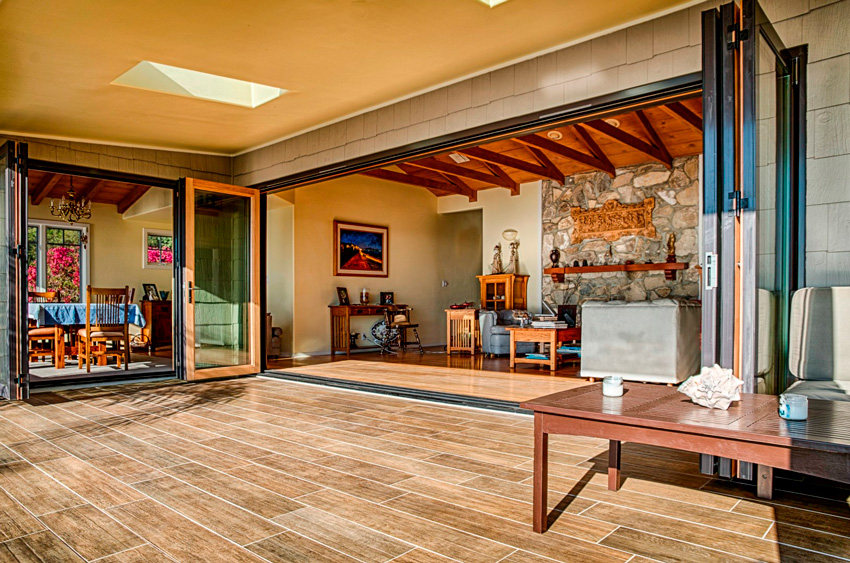Designing Beyond Borders
Sustainable Living: Multi-Panel Door Systems and Universal Design
The term “universal design” was coined by the architect Ronald L. Mace to describe the concept of designing all products and the built environment to be aesthetic and usable to the greatest extent possible by everyone, regardless of their age, ability, or status in life.
In universal design, homes are designed in such a way that they allow occupants to age in place, and so that they facilitate the living experience of everyone, including handicapped residents. Certain features, like wider hallways, lowered window hardware, and wider door openings, allow occupants to seamlessly transition through the phases of life without having to move or remodel. Multi-panel door systems offer a natural solution for aging-in-place design considerations. They also offer an aesthetic range to allow for a variety of styles in universal design.
Aging-in-place design features include:
- Door Thresholds: Flush preferable
- Interior Doors: There needs to be 32 inches of clear width, which requires a 36-inch door
- Levered door hardware
- Plenty of windows for natural light
- Lowered windows or taller windows with lower sill height
- Low maintenance exterior and interior finishes
- Easy to operate hardware
The AIA is actively studying and promoting aging-in-place features through its Design for Aging (DFA), to “foster design innovation and disseminate knowledge necessary to enhance the built environment and quality of life for an aging society.”
Not only has the DFA Knowledge Community recognized the importance of flexibility and adaptability in design, it has also documented the vital role that green features play in aging-in-place. During its biennial Design for Aging Review design competition in 2013, the green features with the greatest jury-recognized impact were maximized daylighting (64 percent of the green projects recognized by the jury); energy efficiency (61 percent); and site design considerations (42 percent). Sixty-five percent of the jury-recognized projects also described a connection to nature. These projects captured views to parklands, oceans, gardens, and orchards and buildings were planned around natural site features as well as including indoor/outdoor spaces. Many of the awarded projects included abundant natural light, both in common spaces and within residential units. Two projects specifically noted the inclusion of daylight to regulate circadian rhythms and minimize the effects of sundowning in their buildings’ dementia populations. Because of their ability to achieve flexibility, meet compliance standards, and create environmental benefits, multi-panel door systems can offer a unique solution for universal and aging-in-place designs.
ADA Compliance
In some cases, universal designs may wish to consider ADA compliance.
The ADA requirements for commercial use include:
- A door may swing out of a room as long as there is a 48-inch clear area in front of the door to allow those in a wheelchair to safely maneuver.
- For the door to swing in, there must be a full 60 inches of maneuvering space in front of the door, as well as 18 inches of clearance along the side of the door.
- Doorway thresholds may not be more than ½ inch, or ¾ inch for exterior sliding doors.
For ADA compliancy, some multi-panel door systems offer a ramp sill and threshold option for folding and swing door systems, along with panic hardware. If required, a 10-inch bottom rail option can be selected.
For an outswing folding system, the ramp sill is an option when the interior and exterior floor levels are the same and a maximum sill height from finish floor of ½ inch is required. Surface mounted sweeps applied to the bottom of the panels are provided. Adequate overhangs are recommended to reduce risk of water infiltration in these installations.
Conclusion
People are innately attracted to light, open, airy spaces. Home and nature are not spaces in opposition. The most welcoming interior spaces find a way to translate these variables from nature and bring them inside. Characterized by symmetry and balance, this aesthetic transcends design trends and translates instead into a variety of styles. The successful, healthy, sustainable home erases the distinction between indoors and out for both the beauty of its aesthetics and the health benefits it brings to occupants. Under the Green and Healthy Homes Initiative definition, a green and healthy home supports the people living there in many different ways. A healthy home is dry, clean, safe, well-ventilated, pest-free, contaminant-free, well-maintained, and energy-efficient. A sustainable home is a healthy home, and that goal is an all-encompassing one.
By their very design, multi-panel door systems enable this engagement between interior and outdoor spaces. By literally removing the walls and barriers between nature and the interior of a structure, multi-panel systems offer seamless openings that blend the exterior space into a room or series of rooms, eliminating the perceived divide.
Not only do multi-panel door systems improve important health metrics, such as indoor air quality, as enhancements in manufacturing and technology have augmented door and glass efficiency, these systems can occupy a greater area in the building envelope without compromising overall energy performance. The best systems are not only built to visually and physically engage spaces but also to perform when called upon.
Amanda Voss, MPP, is an author, editor, and policy analyst. Writing for multiple publications, she also serves as the managing editor for Energy Design Update.

|
LaCantina Doors is the leader in designing and manufacturing products that create large open spaces. Offering the most innovative and comprehensive range of folding, sliding and swing systems available, LaCantina Doors utilizes the same signature narrow stile and rail profile across its product line for a complete and perfectly matching door package. Designed and made in California, LaCantina Doors have contributed to award winning projects ranging from residential, retail, commercial, educational facilities, resorts and is the preferred choice when it comes to products that open spaces. Backed by an industry leading warranty, LaCantina Doors are available across the U.S. and Internationally. www.lacantinadoors.com |










